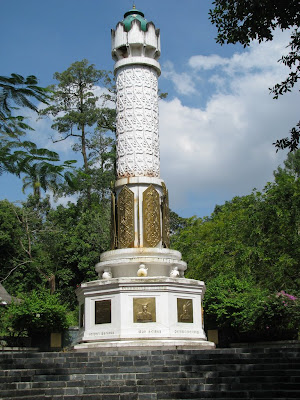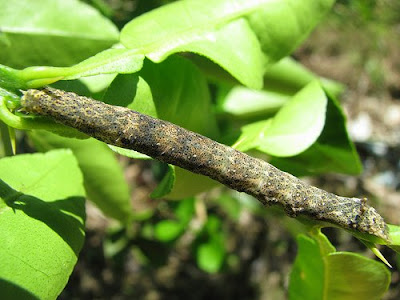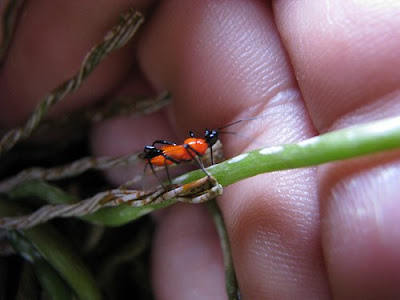Photo blog on nature, wildlife and macro entophiles photography. Photo and pictures of interesting places and landmark in Borneo and Borneo wallpaper download
May 12, 2008
May 10, 2008
Snake head fish photo
Snake head fish has been called with names such as Evil Snakehead, voracious fish, nightmarish creatures, predacious, awful and dreadful fish.
A snakehead fish is a large, predatory freshwater fish native to Africa, Malaysia, Indonesia, and other parts of Asia. There are 28 varieties of snakehead fish. The snakehead is imported to the U.S. as a food fish and also for the aquarium trade where many thousands are sold every year as pets.
The snakehead fish is unique in several ways from most other fish. Similar in body-type to a muscular eel, some varieties can grow to 4 feet (1.2m) in length. The snakehead has a flat snake-like head and toothed maw, hence it's name. What makes the snakehead so unique, however, is its voracious appetite and its ability to breathe air. In fact the snakehead can travel short distances across land and live for up to three days out of water! It will eat fish equal in size to itself and will consume small mammals as well. There are even reports in Asia of snakeheads attacking and killing humans.
Snake head fish
Snake head fish, full body shot
The northern snakehead is extremely adaptable to various climates including cold waters, and like all snakeheads, breeds easily. Adaptability, carnivorous appetitive, lack of natural enemies and ability to transverse land, makes the northern snakehead a real threat to U.S. waterways and indigenous species of fish and amphibians. Tropical and subtropical breeds of snakeheads can pose an additional threat to warmer waterways like those in Florida and Hawaii.
Photos taken at Sarawak Museum Aquarium
Related posts:
* Tropical Transparent Fish - Glass Fish - X-Ray Fish
Posted by RWS at 9:13 PM 5 comments
Labels: Fish
May 8, 2008
Sarawak Warrior Monument
Sarawak Warrior Monument park which is located next to the Sarawak Museum complex in Kuching is built to honor past multi ethnic warriors of Sarawak namely Datuk Patinggi Ali, Sherip Mashor, Rentap, Rosli Dhobi, Sawing and Liu Shan Bang.
The park is actually build on an old plot of chinese graveyard, so don't be suprise if you stumble upon one of them ( there's lots of them!) while strolling in the park.
At the base of the monument are bronze plaques or murals depicting the local warriors. The Sarawak Warrior Monument was constructed in November 29, 1990
Sarawak Warrior Monument
Datuk Patinggi Ali
Sherip Mashor
Rentap
Rosli Dhobi
Sawing
Liu Shan Bang
Posted by RWS at 7:57 PM 0 comments
May 4, 2008
Brown patterned caterpillar - Series #8
This is the 8th series on tropical caterpillar. This time, it's about a brown patterned caterpillar. The brown caterpillar was hooked underside of a lime branch and at first glance, it look like a branch because it was brown and patterned. It also looks hideous but a perfect camouflage.
Camouflaged caterpillar.
Related posts:
* Baby caterpillar - Series #7
* Tropical furry caterpillar - Series #6
* Tropical yellowish caterpillar - Series #5 (spiky caterpillar)
* Tropical caterpillar - Series #4 (shoe brush caterpillar)
* Tropical caterpillar - Series #3
* Tropical green caterpillar - Series #2
* Tropical big green leave cutter caterpillar - Series #1
Check out more hi-resolution photos on caterpillars at my Flickr Caterpillar Gallery
Posted by RWS at 10:05 PM 3 comments
Labels: Insect -, Insect - Caterpillar, Nature
May 2, 2008
Baby Caterpillar - Series #7
Gang of baby caterpillars

Close up. That's the closest I can get because the object is too tiny, more closer that the object would be too blur or dark.
Related posts:
* Tropical furry caterpillar - Series #6
* Tropical yellowish caterpillar - Series #5 (spiky caterpillar)
* Tropical caterpillar - Series #4 (shoe brush caterpillar)
* Tropical caterpillar - Series #3
* Tropical green caterpillar - Series #2
* Tropical big green leave cutter caterpillar - Series #1
Check out more hi-resolution photos on caterpillars at my Flickr Caterpillar Gallery
Posted by RWS at 11:18 PM 1 comments
Labels: Insect -, Insect - Caterpillar, Nature
Apr 27, 2008
Tropical plant - Mimosa Pudica - Sensitive plant
This entry is about a special plant called Mimosa Pudica that is able to folds its leaves when touched or exposed to heat. When touched, the leaves folds as if it alive.
Common name for this plant is "Sensitive plant" or "Shy plant". In Malaysia, it is called "Semalu". Based on the common name, the impression is that the plant is "shy" because of its folding capability when touched.
Mimosa Pudica shrub
Mimosa Pudica bloom
More about Mimosa
Mimosa is a genus of about 400 species of herbs and shrubs, in the subfamily Mimosoideae of the legume family Fabaceae. The most curious plant in the genus is Mimosa pudica because of the way it folds its leaves when touched or exposed to heat; many others also fold their leaves in the evening. It is native to southern Mexico, Uruguay and Central America but is widely cultivated elsewhere for its curiosity value, both as an indoor plant in temperate areas, and outdoors in the tropics. Outdoor cultivation has led to weedy invasion in some areas, notably Hawaii.
Members of this genus are among the few plants capable of rapid movement; examples outside of Mimosa include the Telegraph plant, and the Venus Flytrap.
The genus Mimosa has had a tortuous history, having gone through periods of splitting and lumping, ultimately accumulating over 3,000 names, many of which have either been synonymized under other species or transferred to other genera. In part due to these changing circumscriptions, the name "Mimosa" has also been applied to several other related species with similar pinnate or bipinnate leaves but now classified in other genera, most commonly to Albizia julibrissin (Silk Tree) and Acacia dealbata (Silver Wattle).
The plant can be found in many parts of Bengal, where it is known as lajjabati (literally a shy female).
Mimosa Pudica
Mimosa pudica is well known for its rapid plant movement. In the evening the leaflets will fold together and the whole leaf droops downward. It then re-opens at sunrise. This type of motion has been termed nyctinastic movement. The leaves also close up under various other stimuli, such as touching, warming, or shaking. The stimulus can also be transmitted to neighbouring leaves. These types of movements have been termed seismonastic movements. The movement is caused by "a rapid loss of pressure in strategically situated cells that cause the leaves to droop right before one’s eyes". This characteristic is quite common within the Mimosaceae family.
For more hi-resolution photos, check out my Flickr Gallery: Plant
Posted by RWS at 9:15 AM 5 comments
Labels: plant
Apr 22, 2008
Tropical yellow bug
This entry is about a yellow bug.
Yellow bug live on YouTube
More hi-resolution photo on my Flickr Insect and Bug gallery.
Posted by RWS at 8:31 AM 1 comments
Labels: Insect -, Insect - Bugs
Apr 17, 2008
Red-weevil bug - Series #2
This entry is the second series on Red weevil-like insects.
Tinny red weevil on a nail head.
Tiny weevil with my palm at the background.
Tiny weevil on mosses. The green thing is an orchid root.
More hi-resolution photo on my Flickr Insect and Bug gallery.
Related posts:
* Red Weevil-like Insect - Series #1
Posted by RWS at 3:07 PM 1 comments
Labels: Insect -, Insect - Bugs
About RWSPhoto Blog
Best Photo Collections
Photo Themes
- 18SX (1)
- Albino (2)
- Animal Oddities (51)
- Ant (2)
- Beach (2)
- Bintulu (1)
- Bintulu Port (2)
- Bird (5)
- branched coconut (1)
- Bugs - Hemiptera (1)
- Bugs - Hemiptera - Heteroptera (1)
- Butterfly - Junonia Orithya (1)
- Butterfly - Papilio Polymnestor (1)
- Chameleon (1)
- Container Terminal (1)
- crab (1)
- Culture (12)
- Dragon Statue (1)
- Environment (1)
- Event (6)
- Fish (7)
- Flower (8)
- freak (3)
- Fruit (8)
- fun (1)
- Fungi (11)
- Grasshopper (1)
- Insect - (70)
- Insect - Acrididae - Locust (4)
- Insect - Beetle (5)
- Insect - Bugs (11)
- Insect - Butterfly (10)
- Insect - Caterpillar (26)
- Insect - Damselfly (2)
- Insect - Dragonfly (3)
- Insect - Fly (6)
- Insect - Gerridae (1)
- Insect - Mantis (1)
- Insect - Moth (7)
- Insect - Sex (13)
- Insect - Spider (7)
- Insect - Wasps (3)
- Insect - Weevil (4)
- International Pix (53)
- Invertebrate - Millipede (2)
- Kota Kinabalu (1)
- Kuching (9)
- Landmark (6)
- Local Scene (2)
- Macaque (2)
- Menara Kidurong (1)
- Miri (1)
- Miscellaneous (4)
- Monkey Cup (1)
- Monument (1)
- Mushroom (12)
- National Park (4)
- Nature (37)
- Nepenthes (1)
- Padi (12)
- Pagoda (2)
- Pets (9)
- Photo Collection (1)
- Photo Illustration (1)
- Photo Repository (1)
- Pitcher Plant (1)
- plant (10)
- Port (1)
- Reptile (4)
- Sandakan (1)
- Sepangar Bay Container Terminal (1)
- Sepangar Port (1)
- Shoreline (3)
- Sibu (3)
- Snake (1)
- Sunset (1)
- Technology (1)
- Tropical Flower - Ixora (5)
- Tuaran (1)
- Wild Animal (6)


